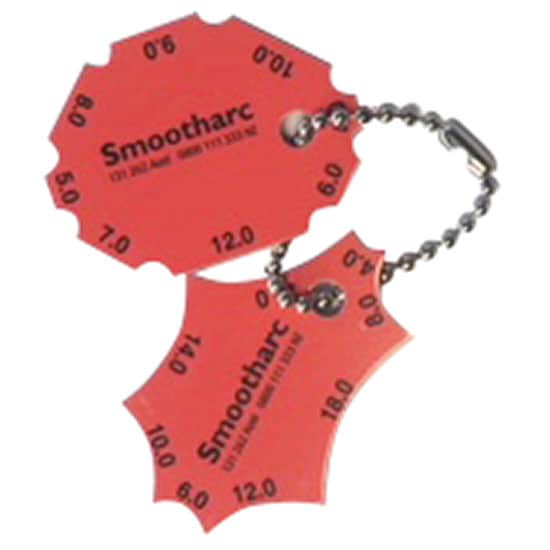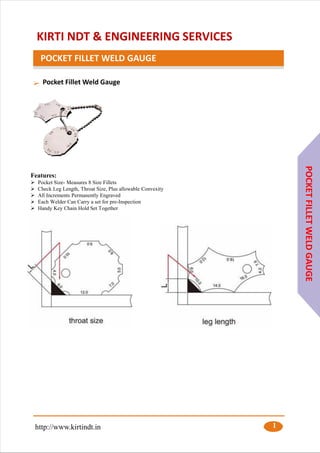Leading Methods for Measuring Gauge Fillet Weld Precisely
Leading Methods for Measuring Gauge Fillet Weld Precisely
Blog Article
Innovative Techniques to Fillet Weld Examination and Testing: Enhancing Weld Quality and Compliance Criteria
In the world of welding, the quality and honesty of fillet welds play an important function in making certain the architectural stability and reliability of different industrial parts. With the continuous drive for boosted effectiveness and conformity with strict standards, the expedition of innovative strategies to fillet weld assessment and testing has actually become critical.
Advanced Non-Destructive Testing Approaches
Using modern innovations, progressed non-destructive testing methods play a critical function in making sure the integrity and quality of fillet welds. These methods, such as phased array ultrasonic testing (PAUT) and magnetic fragment testing (MPT), deal comprehensive understandings into the weld's inner structure without triggering any kind of damages to the material. PAUT, for example, makes use of multiple ultrasonic aspects to evaluate the weld from various angles, supplying a detailed visualization of possible defects like lack of combination or splits.
Similarly, MPT works in detecting surface-breaking flaws by using an electromagnetic field and iron bits to the weld location. This approach is specifically useful for determining stoppages that may compromise the weld's strength. By utilizing these sophisticated non-destructive screening strategies, weld assessors can properly assess the quality of fillet welds, guaranteeing conformity with market criteria and laws. The capacity to detect defects early not just improves weld high quality however likewise stops pricey rework or failures in structural stability, highlighting the relevance of these ingenious screening strategies in welding evaluations.
Robotics and Automation in Evaluation

The integration of robotics and automation has actually reinvented the assessment process for fillet welds, boosting effectiveness and precision in high quality assessment. Robotics supply exact control and repeatability in examining welds, ensuring reputable and consistent outcomes. Automated systems can be programmed to adhere to particular inspection courses, guaranteeing thorough protection of welds and reducing the threat of human error.
Robot evaluation systems outfitted with sophisticated sensing units can detect and measure weld attributes with high precision, offering detailed information for evaluation. These systems can identify flaws such as cracks, absence of blend, and porosity, allowing punctual corrective actions to be taken. In addition, robotics and automation allow for real-time information collection and evaluation, supplying prompt feedback to operators and helping with quick decision-making procedures.
Additionally, the usage of robotics and automation in fillet weld inspection improves general efficiency by minimizing examination times and increasing evaluation throughput. By enhancing the inspection process, makers can make certain weld top quality and compliance requirements are satisfied successfully, inevitably leading to cost savings and improved product high quality.
Making Use Of Artificial Knowledge for Evaluation
Man-made intelligence plays a pivotal duty in enhancing the efficiency and precision of evaluation in fillet weld evaluation procedures. AI formulas can rapidly refine huge amounts of information from weld assessments, discovering problems or inconsistencies that might be challenging to identify with the nude eye.
Furthermore, AI systems can pick up from previous evaluation information, continuously enhancing their ability to determine potential flaws and discrepancies in fillet welds. This flexible knowing capability improves the total quality assurance procedure, decreasing the chance of human error and making certain that welds satisfy the called for requirements. By incorporating expert system right into fillet weld evaluation, markets can achieve greater degrees of performance, uniformity, and conformity in their evaluation techniques.
Portable Equipment for On-Site Examination
Enhancing field assessment efficiency, the fostering of mobile tools changes on-site evaluation procedures for fillet welds. These tools supply adaptability and convenience, enabling assessors to perform extensive exams in various places, consisting of challenging or remote atmospheres. Mobile tools such as ultrasonic testing gadgets, magnetic go bit examination equipment, and digital radiography systems supply real-time information and high-resolution imaging capacities, enabling quick decision-making and instant comments on weld top quality.
One substantial benefit of mobile devices is their capability to streamline evaluation treatments, minimizing downtime and boosting total performance - Gauge Fillet Weld. Assessors can conveniently transfer these devices to different task websites, removing the demand for transferring heavy machinery or components to off-site facilities. In addition, the mobility of these tools advertises cost-effectiveness by reducing transportation expenditures and increasing assessment timelines
Moreover, the use of portable devices for on-site examination advertises aggressive top quality control actions, as assessors can immediately determine and attend to any type of prospective welding defects or discrepancies. By integrating these ingenious innovations into on-site inspection practices, welding specialists can make certain conformity with industry criteria and boost weld high quality, ultimately leading to boosted architectural stability and safety in numerous welding applications.
Assimilation of Data Management Solution

Having maximized on-site assessment processes with the utilization of portable devices, the following phase includes the smooth integration of information management systems to even more boost efficiency and information analysis capabilities in fillet weld examination and testing. By integrating information monitoring systems into the evaluation process, organizations can enhance information collection, storage space, and evaluation. This combination permits for real-time tracking of weld top quality, prompt identification of issues, and prompt decision-making to correct any type of concerns that may develop throughout the inspection process.
The assimilation of information administration systems makes it possible for smooth interaction in between different stakeholders involved in the assessment process, cultivating cooperation and improving overall top quality control procedures. Eventually, the combination of data monitoring systems serves to boost the requirements of fillet weld inspection and screening, guaranteeing conformity with market regulations and improving weld quality.
Verdict
In conclusion, cutting-edge methods to fillet weld examination and screening have actually substantially boosted weld high quality and conformity standards. Advanced non-destructive screening methods, robotics, automation, expert system, mobile devices, Extra resources and data administration systems have reinvented the means weld evaluations are performed. By utilizing these modern technologies, industries can make sure that welds fulfill the required quality requirements and guidelines, eventually boosting general performance and security in welding procedures.

Having actually enhanced on-site evaluation processes through the utilization of portable devices, the following phase involves the seamless combination of data management systems to further boost efficiency and data analysis capacities in fillet weld assessment and testing. Ultimately, the integration of information monitoring systems serves to elevate the criteria of fillet weld evaluation and testing, ensuring conformity with market regulations and boosting weld high quality.

Report this page